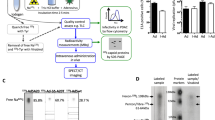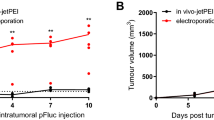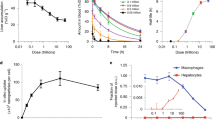Abstract
Direct intratumoural (IT) administration of adenovirus is widely used, however little is known about the resulting distribution of virus particles. Here we have evaluated the influence of tumour size, volume of injectate and occlusion of injection sites (to prevent retrograde seepage) on particle biodistribution and transgene expression. In subcutaneous MDA-231 xenografts, IT injection of relatively large volumes (4 × 20% (vol/vol) injections) resulted in just 40% of the administered dose being retained in tumour tissue after 30 min, with 15% in the liver thought to reflect systemic ‘overflow’. Occlusion of the injection sites using surgical adhesive increased retention of the vector to 80% in the tumour with no increase in liver levels. Spread of expression was enhanced using multiple injection sites, but not by using larger injectate volumes. In ZR75.1 breast carcinoma xenografts virus distribution was different, with no evidence of systemic overflow leading to hepatic transduction following IT injection. Typically, clinical doses employ up to 30% vol/vol IT injections. Depending on the tumour, this may give considerable systemic overflow and might account for the high frequency of fevers observed. Virus performance might be improved by tailoring volumes and frequency of IT injection for tumour biology or histotype.
This is a preview of subscription content, access via your institution
Access options
Subscribe to this journal
Receive 12 print issues and online access
$259.00 per year
only $21.58 per issue
Buy this article
- Purchase on Springer Link
- Instant access to full article PDF
Prices may be subject to local taxes which are calculated during checkout




Similar content being viewed by others
References
Zhang SW, Xiao SW, Liu CQ, Sun Y, Su X, Li DM et al. Recombinant adenovirus-p53 gene therapy combined with radiotherapy for head and neck squamous-cell carcinoma. Zhonghua Zhong Liu Za Zhi 2005; 27: 426–428.
Zhang SW, Xiao SW, Liu CQ, Sun Y, Su X, Li DM et al. Treatment of head and neck squamous cell carcinoma by recombinant adenovirus-p53 combined with radiotherapy: a phase II clinical trial of 42 cases. Zhonghua Yi Xue Za Zhi 2003; 83: 2023–2028.
Morley S, MacDonald G, Kirn D, Kaye S, Brown R, Soutar D . The dl1520 virus is found preferentially in tumor tissue after direct intratumoral injection in oral carcinoma. Clin Cancer Res 2004; 10: 4357–4362.
Lyons M, Onion D, Green NK, Aslan K, Rajaratnam R, Bazan-Peregrino M et al. Adenovirus type 5 interactions with human blood cells may compromise systemic delivery. Mol Ther 2006; 14: 118–128.
Edelman J, Edelman J, Nemunaitis J . Adenoviral p53 gene therapy in squamous cell cancer of the head and neck region. Curr Opin Mol Ther 2003; 5: 611–617.
Nemunaitis J, Khuri F, Ganly I, Arseneau J, Posner M, Vokes E et al. Phase II trial of intratumoral administration of ONYX-015, a replication-selective adenovirus, in patients with refractory head and neck cancer. J Clin Oncol 2001; 19: 289–298.
Stohrer M, Boucher Y, Stangassinger M, Jain RK . Oncotic pressure in solid tumors is elevated. Cancer Res 2000; 60: 4251–4255.
Cusack JC, Spitz FR, Nguyen D, Zhang WW, Cristiano RJ, Roth JA . High levels of gene transduction in human lung tumors following intralesional injection of recombinant adenovirus. Cancer Gene Ther 1996; 3: 245–249.
Lieber A, He CY, Meuse L, Schowalter D, Kirillova I, Winther B et al. The role of Kupffer cell activation and viral gene expression in early liver toxicity after infusion of recombinant adenovirus vectors. J Virol 1997; 71: 8798–8807.
Shayakhmetov DM, Li ZY, Ni S, Lieber A . Analysis of adenovirus sequestration in the liver, transduction of hepatic cells, and innate toxicity after injection of fiber-modified vectors. J Virol 2004; 78: 5368–5381.
Schnell MA, Zhang Y, Tazelaar J, Gao GP, Yu QC, Qian R et al. Activation of innate immunity in nonhuman primates following intraportal administration of adenoviral vectors. Mol Ther 2001; 3: 708–722.
Lozier JN, Csako G, Mondoro TH, Krizek DM, Metzger ME, Costello R et al. Toxicity of a first-generation adenoviral vector in rhesus macaques. Hum Gene Ther 2002; 13: 113–124.
Schiedner G, Bloch W, Hertel S, Johnston M, Molojavyi A, Dries V et al. A hemodynamic response to intravenous adenovirus vector particles is caused by systemic Kupffer cell-mediated activation of endothelial cells. Hum Gene Ther 2003; 14: 1631–1641.
Muruve DA . The innate immune response to adenovirus vectors. Hum Gene Ther 2004; 15: 1157–1166.
Kiang A, Hartman ZC, Everett RS, Serra D, Jiang H, Frank MM et al. Multiple innate inflammatory responses induced after systemic adenovirus vector delivery depend on a functional complement system. Mol Ther 2006; 14: 588–598.
Sauthoff H, Hu J, Maca C, Goldman M, Heitner S, Yee H et al. Intratumoral spread of wild-type adenovirus is limited after local injection of human xenograft tumors: virus persists and spreads systemically at late time points. Hum Gene Ther 2003; 14: 425–433.
DeWeese TL, van der Poel H, Li S, Mikhak B, Drew R, Goemann M et al. A phase I trial of CV706, a replication-competent, PSA selective oncolytic adenovirus, for the treatment of locally recurrent prostate cancer following radiation therapy. Cancer Res 2001; 61: 7464–7472.
Palmer DH, Mautner V, Mirza D, Oliff S, Gerritsen W, van der Sijp JR et al. Virus-directed enzyme prodrug therapy: intratumoral administration of a replication-deficient adenovirus encoding nitroreductase to patients with resectable liver cancer. J Clin Oncol 2004; 22: 1546–1552.
Wang Y, Wang H, Li CY, Yuan F . Effects of rate, volume, and dose of intratumoral infusion on virus dissemination in local gene delivery. Mol Cancer Ther 2006; 5: 362–366.
Tong AW, Nemunaitis J, Su D, Zhang Y, Cunningham C, Senzer N et al. Intratumoral injection of INGN 241, a nonreplicating adenovector expressing the melanoma-differentiation associated gene-7 (mda-7/IL24): biologic outcome in advanced cancer patients. Mol Ther 2005; 11: 160–172.
Gordon LA, Mulligan KT, Maxwell-Jones H, Adams M, Walker RA, Jones JL . Breast cell invasive potential relates to the myoepithelial phenotype. Int J Cancer 2003; 106: 8–16.
Green NK, Herbert CW, Hale SJ, Hale AB, Mautner V, Harkins R et al. Extended plasma circulation time and decreased toxicity of polymer-coated adenovirus. Gene Therapy 2004; 11: 1256–1263.
Raper SE, Chirmule N, Lee FS, Wivel NA, Bagg A, Gao GP et al. Fatal systemic inflammatory response syndrome in a ornithine transcarbamylase deficient patient following adenoviral gene transfer. Mol Genet Metab 2003; 80: 148–158.
Manickan E, Smith JS, Tian J, Eggerman TL, Lozier JN, Muller J et al. Rapid Kupffer cell death after intravenous injection of adenovirus vectors. Mol Ther 2006; 13: 108–117.
Bhujwalla ZM, Artemov D, Ballesteros P, Cerdan S, Gillies RJ, Solaiyappan M . Combined vascular and extracellular pH imaging of solid tumors. NMR Biomed 2002; 15: 114–119.
Bhujwalla ZM, Artemov D, Natarajan K, Ackerstaff E, Solaiyappan M . Vascular differences detected by MRI for metastatic versus nonmetastatic breast and prostate cancer xenografts. Neoplasia 2001; 3: 143–153.
Muruve DA, Cotter MJ, Zaiss AK, White LR, Liu Q, Chan T et al. Helper-dependent adenovirus vectors elicit intact innate but attenuated adaptive host immune responses in vivo. J Virol 2004; 78: 5966–5972.
Machemer T, Engler H, Tsai V, Lee S, Cannon-Carlson S, Voloch M et al. Characterization of hemodynamic events following intravascular infusion of recombinant adenovirus reveals possible solutions for mitigating cardiovascular responses. Mol Ther 2005; 12: 254–263.
Varnavski AN, Zhang Y, Schnell M, Tazelaar J, Louboutin JP, Yu QC et al. Preexisting immunity to adenovirus in rhesus monkeys fails to prevent vector-induced toxicity. J Virol 2002; 76: 5711–5719.
Wolins N, Lozier J, Eggerman TL, Jones E, Aguilar-Cordova E, Vostal JG . Intravenous administration of replication-incompetent adenovirus to rhesus monkeys induces thrombocytopenia by increasing in vivo platelet clearance. Br J Haematol 2003; 123: 903–905.
Raper SE, Yudkoff M, Chirmule N, Gao GP, Nunes F, Haskal ZJ et al. A pilot study of in vivo liver-directed gene transfer with an adenoviral vector in partial ornithine transcarbamylase deficiency. Hum Gene Ther 2002; 13: 163–175.
Mulvihill S, Warren R, Venook A, Adler A, Randlev B, Heise C et al. Safety and feasibility of injection with an E1B-55 kDa gene-deleted, replication-selective adenovirus (ONYX-015) into primary carcinomas of the pancreas: a phase I trial. Gene Ther 2001; 8: 308–315.
Swisher SG, Roth JA, Komaki R, Gu J, Lee JJ, Hicks M et al. Induction of p53-regulated genes and tumor regression in lung cancer patients after intratumoral delivery of adenoviral p53 (INGN 201) and radiation therapy. Clin Cancer Res 2003; 9: 93–101.
Acknowledgements
We gratefully acknowledge the support of the Clarendon Fund, Balliol and Magdalen College, University of Oxford and the Consejo Nacional de Ciencia y Tecnologia (CONACYT) (MBP), European Union (RCC, LSHB-CT-2004-512087), Cancer Research UK (LP) and the National Translational Cancer Research Network (LWS).
Author information
Authors and Affiliations
Corresponding author
Rights and permissions
About this article
Cite this article
Bazan-Peregrino, M., Carlisle, R., Purdie, L. et al. Factors influencing retention of adenovirus within tumours following direct intratumoural injection. Gene Ther 15, 688–694 (2008). https://doi.org/10.1038/gt.2008.2
Received:
Revised:
Accepted:
Published:
Issue Date:
DOI: https://doi.org/10.1038/gt.2008.2
Keywords
This article is cited by
-
Optimizing oncolytic virotherapy in cancer treatment
Nature Reviews Drug Discovery (2019)
-
Polymeric Cups for Cavitation-mediated Delivery of Oncolytic Vaccinia Virus
Molecular Therapy (2016)
-
Ultrasound as a method to enhance antitumor ability of oncolytic herpes simplex virus for head and neck cancer
Cancer Gene Therapy (2015)
-
Combining virotherapy and angiotherapy for the treatment of breast cancer
Cancer Gene Therapy (2013)
-
Intratumoral delivery of CD154 homolog (Ad-ISF35) induces tumor regression: analysis of vector biodistribution, persistence and gene expression
Cancer Gene Therapy (2012)



